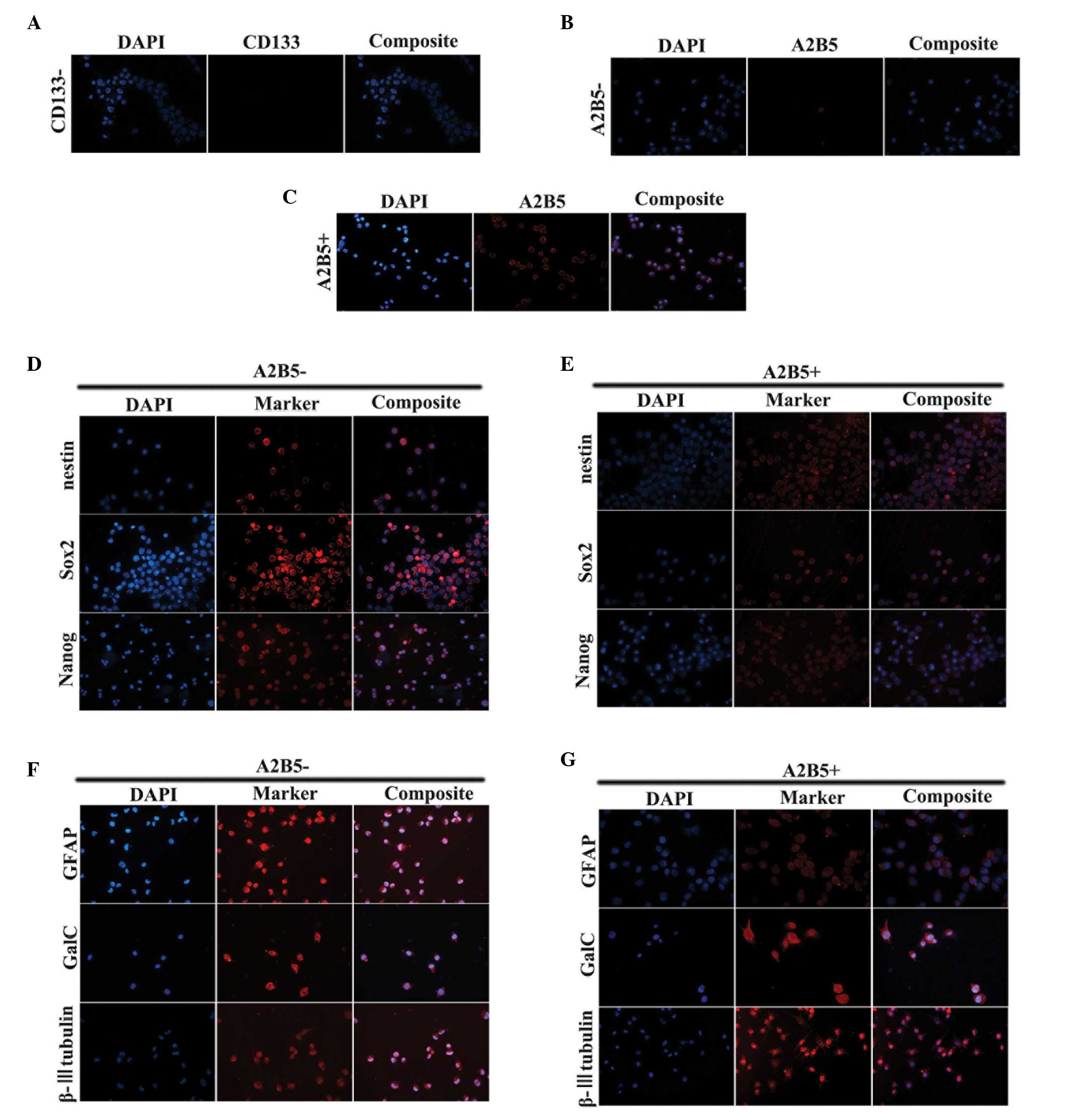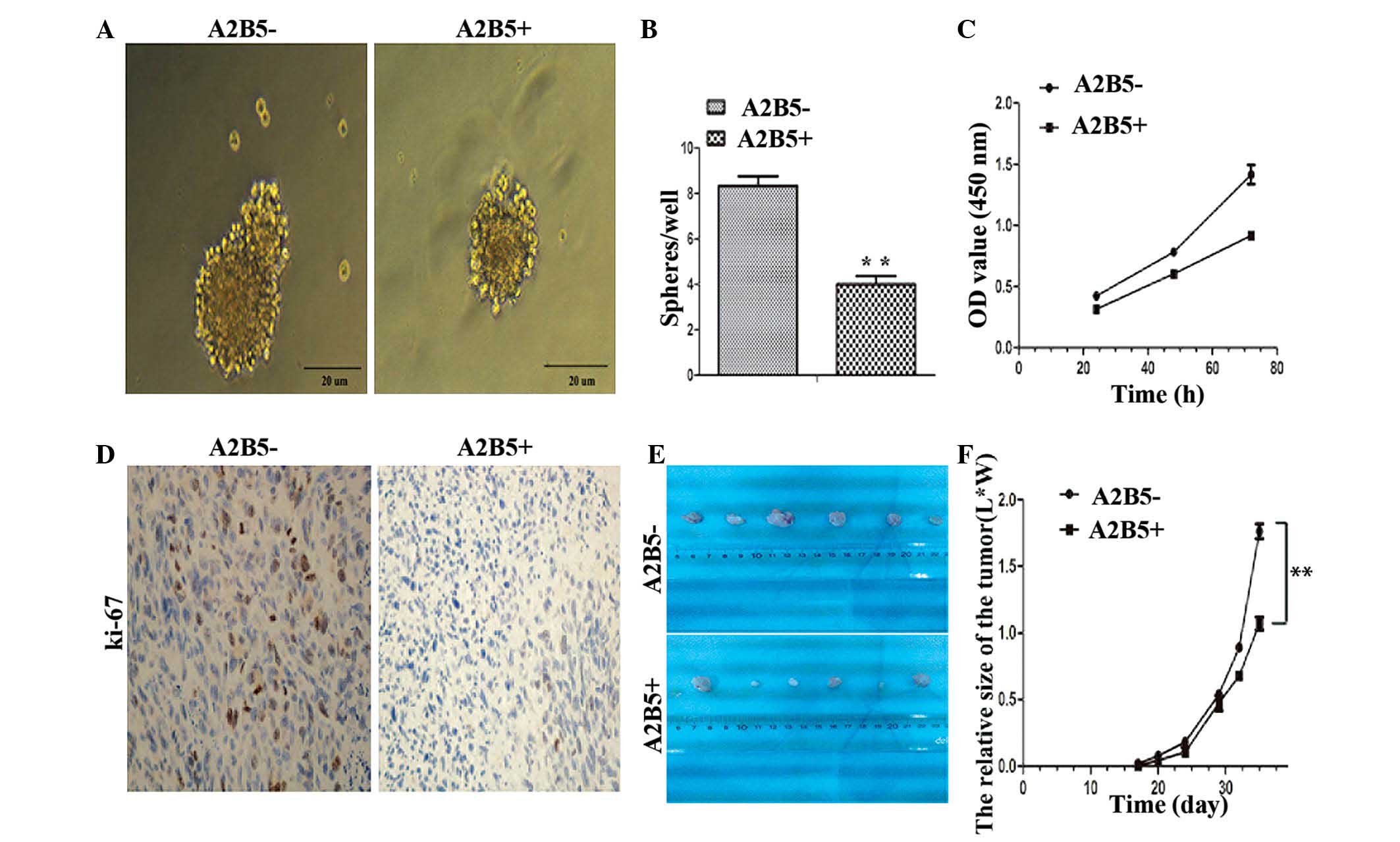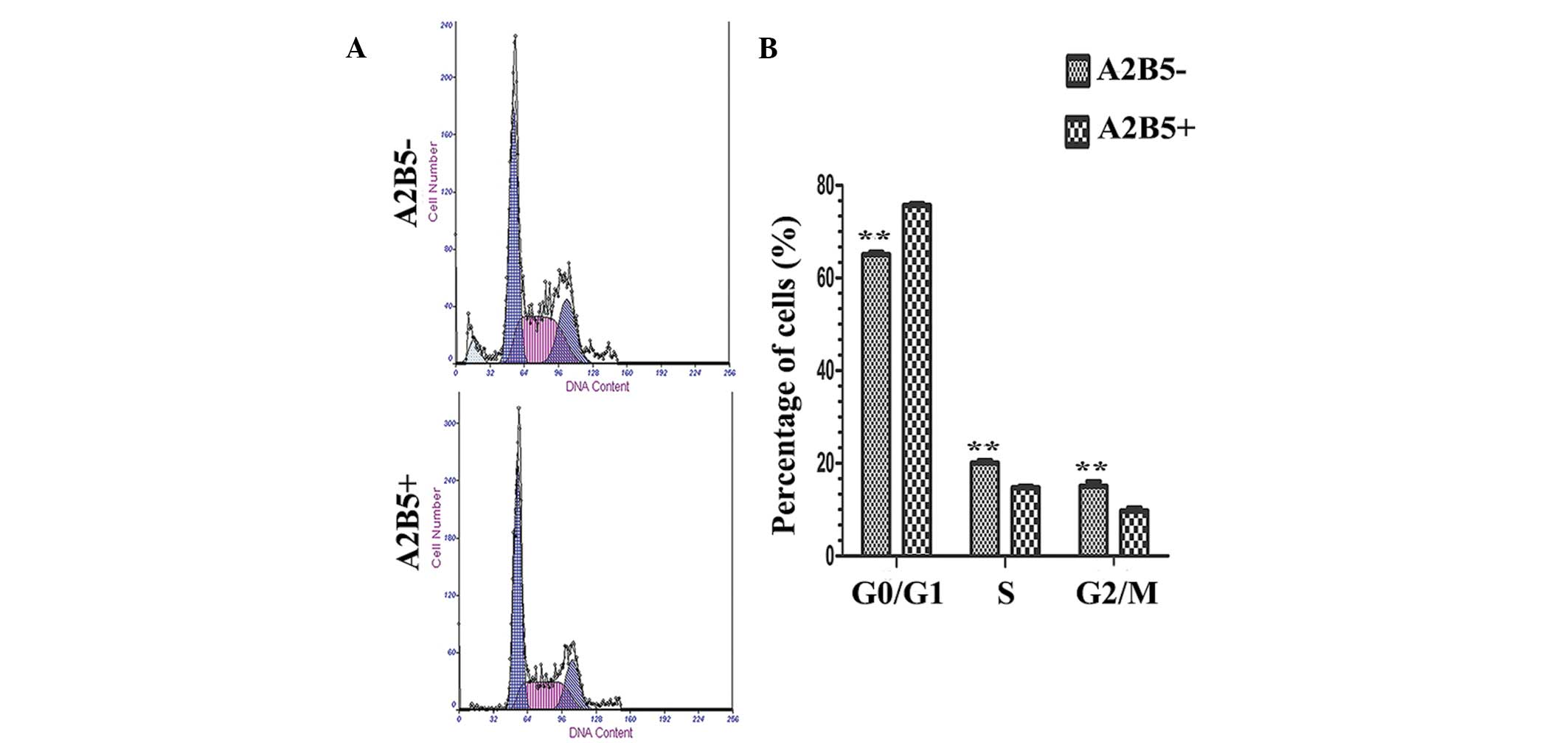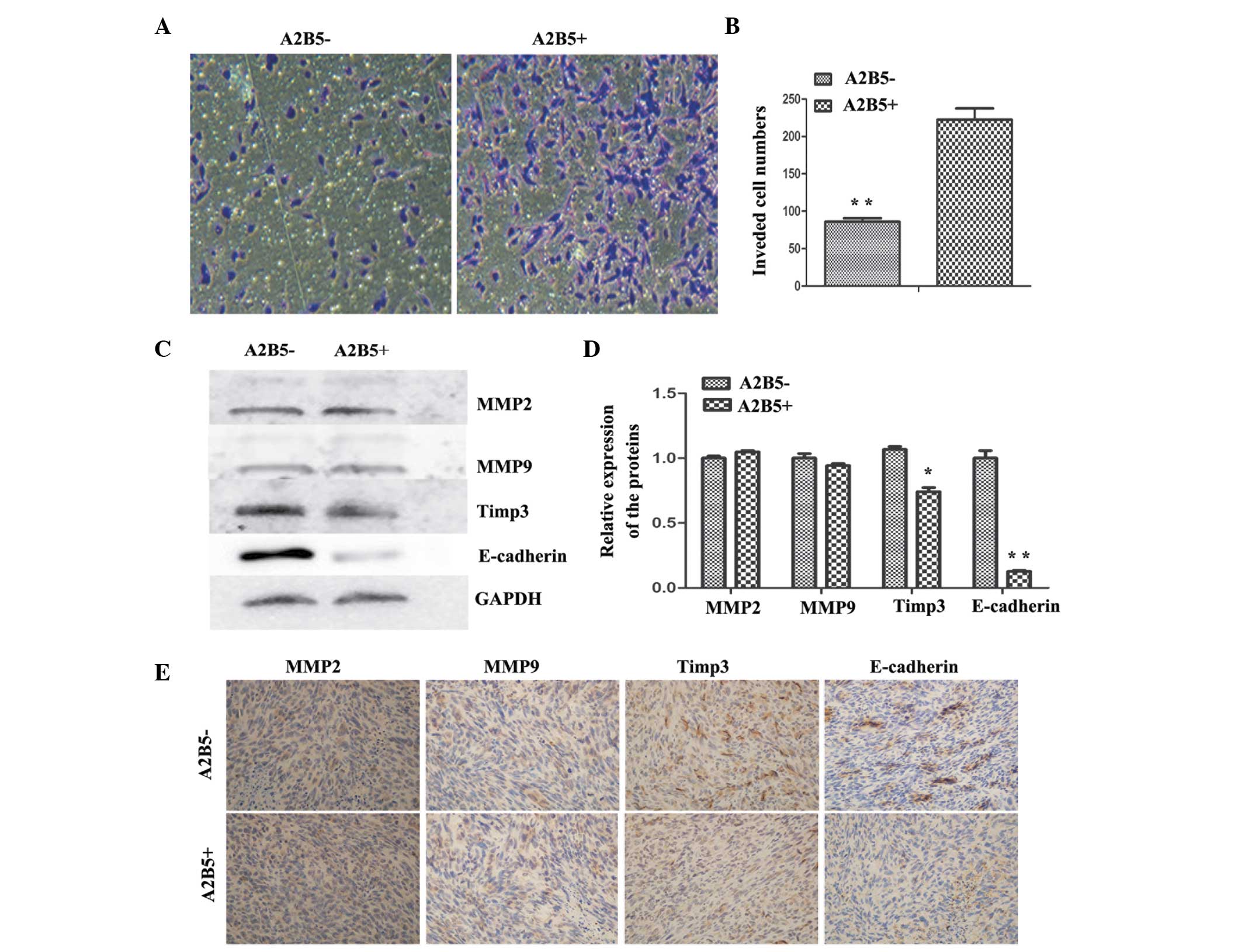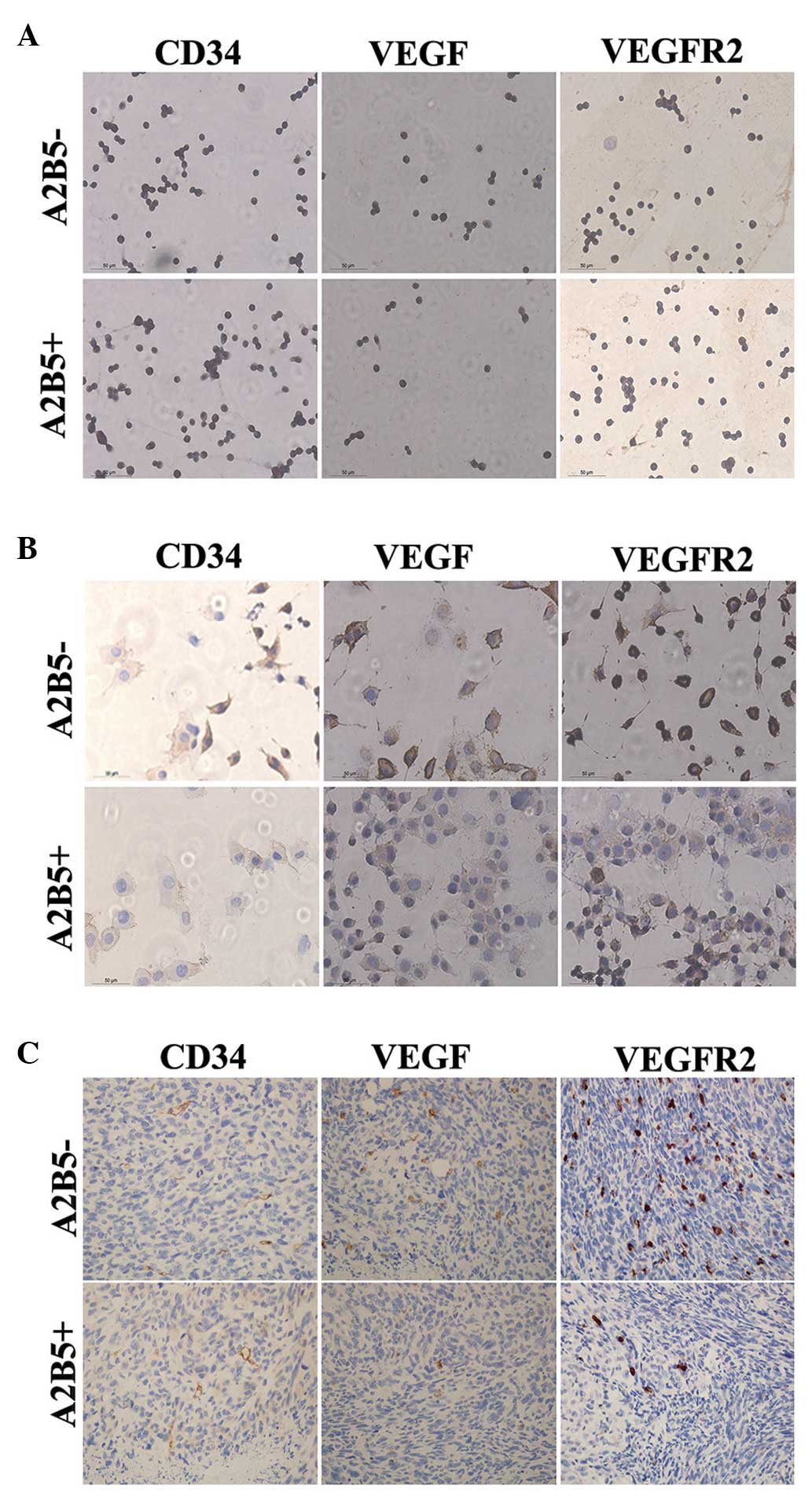Isolation and characteristics of CD133‑/A2B5+ and CD133‑/A2B5‑ cells from the SHG139s cell line
- Authors:
- Published online on: October 15, 2015 https://doi.org/10.3892/mmr.2015.4446
- Pages: 7949-7956
-
Copyright: © Han et al. This is an open access article distributed under the terms of Creative Commons Attribution License.
Abstract
Introduction
It has been reported that gliomas arise following the malignant transformation of neural stem cells or progenitors (1–4). Glioma stem cells (GSCs) are a rare subpopulation of cells within glioma tissues. GSCs have a distinct self-renewal property and can generate all the heterogeneous lineages of cancer cells, which eventually constitute a tumor (5). GSCs are responsible for the initiation, progression, metastasis and recurrence of cancer (6). Investigations on cancer stem cells (CSCs) may assist in further understanding the mechanisms of development of glioma, and may provide a more effective method for their treatment.
In previous studies, several markers of CSCs have been found, including CD133, SSEA1, CD44 and A2B5 (7–9). However, not all CSCs express all of the above-mentioned stem cell markers. In a previous study, it was reported that only CD133+ cells were found in CSCs (5,10). Subsequent studies by Beier et al (5) and Wang et al (11) found the existence of CD133− cells in CSCs. In a previous study, it was reported that A2B5+ cells from glioblastma also exhibit cancer stem-like properties (8). Compared with A2B5− cells from glioblastoma tissue, A2B5+ cells exhibit more marked tumorigenic potential in vivo (7). However, in CSC lines, the differences between A2B5− and A2B5+ cells remain to be fully elucidated.
In the present study, the differences between A2B5− cells and A2B5+ cells from the SHG139s GSC line were compared. A SHG139s GCS line possessing the molecular phenotype of CD133low/A2B5high was cultured and developed in a previous study (12). In order to rule out the effect of the expression of CD133, the CD133+ cells were first excluded using magnetic-activated cell sorting (MACS). As A2B5− and A2B5+ cells from CD133− SHG139s possess stem cell properties the aim of the present study was to investigate whether expression of A2B5 affects proliferation, invasion, and angiogenesis of CD133− SHG139s.
Materials and methods
Cell culture
The SHG139s GSC line was developed and provided by the Neurosurgery and Brain and Nerve Research Laboratory, The First Affiliated Hospital of Soochow University, (Suzhou, China). The SHG139s cell line was maintained in stem-cell permissive medium [Dulbecco's modified Eagle's medium (DMEM)-F12 containing 20 ng/ml epidermal growth factor, basic fibroblast growth factor (bFGF; R&D Systems, Inc., Minneapolis, MN, USA), nitrogen gas (dilution, 1:50) and B27 (dilution, 1:50; Invitrogen; Thermo Fisher Scientific, Inc., Waltham, MA, USA)].
MACS
The cells were dissociated using 0.25% trypsin (Beyotime Institute of Biotechnology, Haimen, China) and resuspended in phosphate-buffered saline (PBS). All reagents and supplies for MACS separation were purchased from Miltenyi Biotec GmbH (Bergisch-Gladbach, Germany). Selection of CD133− SHG139s cells was performed, according to the manufacturer's instructions, using CD133/1 Micro Beads. Subsequently, the CD133− cells were separated from the A2B5+ cells and A2B5− cells, according to the manufacturer's instructions, using A2B5 Micro Beads.
In vitro invasion assay
The CD133−/A2B5+and CD133−/A2B5− cells were transferred onto Matrigel-coated invasion chambers (24-well insert, 8-µm pores; BD Biosciences, Franklin Lakes, NJ, USA), containing serum-free DMEM. DMEM containing 10% fetal bovine serum was added to the lower chamber as a chemoattractant. Following an incubation period at 37.5°C for 48–72 h, non-invading cells were removed from the inner part of the insert using a cotton swab. The cells on the lower membrane surface were fixed in 4% formaldehyde (Beyotime Institute of Biotechnology) and stained with 0.1% crystal violet (Beyotime Institute of Biotechnology). The number of invading cells were manually counted in five randomly-selected fields under a microscope (CKX41SF inverted microscope; Olympus Corporation, Tokyo, Japan) and images were captured.
Western blot analysis
The primary antibodies used in the present study were polyclonal rabbit anti-human tissue inhibitor of metalloproteinase 3 (TIMP3; cat. no. BA0577), polyclonal rabbit anti-human E-cadherin (cat. no. PB0583), polyclonal rabbit anti-human matrix metalloproteinase (MMP) 2 (cat. no. BA0569) and anti-MMP9 (cat. no. BM0573) all purchased from Wuhan Boster Bioengineering Co., Ltd. (Wuhan, China). Total protein from the cells was directly extracted in lysis buffer (Beyotime Institute of Biotechnology) and the concentration of total protein was quantified using an ultraviolet spectrophotometer (Multiskan Mk3; Thermo Fisher Scientific, Waltham, MA, USA). Protein samples (100 or 50 µg) were separated using 12% sodium dodecyl sulfate-polyacrylamide gel electrophoresis (Beyotime Institute of Biotechnology). The proteins were then transferred onto nitrocellulose membranes (Beyotime Institute of Biotechnology) and non-specific binding was blocked by incubating the membranes in 5% non-fat milk. The membranes were incubated at 37°C with primary antibodies overnight at 4°C. Following incubation, the membranes were washed with PBS with Tween-20 and incubated at 37°C for 2 h with horseradish peroxidase (HRP)-conjugated monoclonal goat anti-rabbit secondary antibodies (cat no. Beyotime Institute of Biotechnology; cat. no. A0208), followed by detection and visualization using electrochemiluminescence western blotting detection reagents (Pierce Biotechnology, Inc.; Thermo Fisher Scientific, Inc.). Quantification of protein expression was performed by measuring the gray-scale value of bands using ImageJ software (version 2.1.4.7; National Institutes of Health, Bethesda, MD, USA).
Subcutaneous implanted models
A total of 16 nude mice were separated into two groups (each group comprised of four female and four male mice). The mice were aged ~4–6 weeks and weighed 24–28g. The mice were raised in specific-pathogen free conditions, and the temperature was maintained between 26 and 28°C. The mice were exposed to ~10 h light per day, and given food and water following high-temperature sterilization. The mice were raised separately, but under the same conditions and were fed standard chow. To investigate the effects of A2B5 expression on tumor growth in vivo, cells (1×106) from the two groups (CD133−/A2B5+ and CD133−/A2B5−) were injected into the left axilla of nude mice (n=8). For the injection, the cells were suspended in DMEM-F12 to the same concentration (1×107 cells/ml) and 100 µl cell suspension was injected into each of the mice on the same day. On day 17 post-implantation, caliper measurements were performed to assess tumor growth.
Immunohistochemistry (IHC) and immunofluorescence (ICC)
Mice received an intraperitoneal injection of 45 mg/kg pentobarbital sodium (Shanghai Westang Bio-tech Co., Ltd., Shanghai, China) for anesthetization. The tumors (weight, 1–2.5 g) were excised using tweezers and scissors, and the mice were sacrificed by cervical dislocation. The formalin-fixed paraffin-embedded (Qilin Environmental Technology Firm, Guangzhou, China) SHG139s tumors were cut into 6-µm sections using a microtome (RM2016; Leica Biosystems, Nussloch, Germany). Antigen retrieval was performed in 10 mM sodium citrate buffer (pH 6; Beyotime Institute of Biotechnology) for 16 min at 96–98°C. The slides were then incubated with primary antibodies against MMP9, MMP2, E-cadherin, TIMP3 and Ki-67 (cat. no. BA2888; Wuhan Boster Bioengineering Co., Ltd.), and with antibodies against vascular endothelial growth factor (VEGF; cat. no. ab46154), VEGF receptor 2 (VEGFR2; cat. no. ab2349) and CD34 (cat. no. ab81289; Abcam, Tokyo, Japan). The sections were subsequently incubated with a cell and tissue HRP-DAB staining system (R&D Systems, Inc., Minneapolis, MN, USA), according to the manufacturer's instructions. Immunostaining was performed using tumor controls that were positive (tumors formed by A2B5+ cells) and negative (tumors formed by A2B5− cells), and was evaluated by a pathologist in a blinded-manner. For ICC staining, the cells were seeded onto coverslips (~5×105 cells/ml) and fixed with 4% paraformaldehyde (Sigma-Aldrich), treated with 3% hydrogen peroxide for 10 min and incubated with the antibodies, described above, overnight at 4°C. Fluorescein isothiocyanate- or tetramethyl-rhodamine isothiocyanate-labeled goat anti-rabbit secondary antibodies (1:200; cat. no. ab97178; Abcam) were then added and incubated for 2 h at 37°C. The 4′,6-diamidino-2-phenyl-indole reagent (Wuhan Boster Bioengineering Co., Ltd.) was used to stain the cell nuclei, and the cells were visualized using fluorescence microscopy (BX40F4; Olympus Corporation).
Secondary sphere forming assay
The cells, which were isolated using MACS were seeded (100 cells/well) into 96-well plates in the presence of the stem cell-permissive medium (0.2 ml). The cultures were maintained by replacing half of the medium every 3 days. A subsphere-forming assay (also termed passaging) was repeated every 2 weeks. Following each passage, the number and the size of the spheres were assessed, on days 7 and 14, under a CKX41SF inverted microscope.
Cell cycle analysis and cell proliferation assay
Cells were collected in an exponential growth phase and then fixed with ethanol. Subsequently, RNase A treatment (Beyotime Institute of Biotechnology) and propidium iodide staining were performed. The cells were detected using flow cytometry with a FACSCalibur (BD Biosciences). The number of cells at the G0/G1, S and G2/M phases were quantified using Modfit software (BD Biosciences), excluding the calculation of cell debris and fixation artifacts. Cell proliferation was quantified using a Cell Counting Kit-8 (CCK-8; Beyotime Institute of Biotechnology). Briefly, 100 µl cells (suspended in stem-cell permissive medium) from the two groups (CD133−/A2B5+and CD133−/A2B5+ cells) were seeded onto a 96-well plate at a concentration of 2,000/cells per well and incubated at 37°C. At daily intervals (1, 2 and 3 days), the optical density was measured at 450 nm using a microtiter plate reader (Thermo Multiskan MK3; Thermo Fisher Scientific, Inc.) with the cell survival rate expressed as the absorbance. The results represent the average of six replicates under the same conditions.
Statistical analysis
Statistical analyses were performed using SPSS software, version 13.0 (SPSS, Inc., Chicago, IL, USA). Statistical significance was determined using two-tailed Student's t-test and data are expressed as the mean ± standard error. P<0.05 was considered to indicate a statistically significant difference.
Results
Isolation and stem cell characteristics of CD133−/A2B5+ and CD133−/A2B5− cells of SHG139s
The SHG139s cells were dissociated using 0.25% trypsin, following which the cells were subjected to MACS. The results revealed two groups of cells: CD133−/A2B5+ and CD133−/A2B5− cells. The purity of the isolated cells was determined using ICC, and the purity of the two groups was >90% (Fig. 1A–C).
The ICC staining also demonstrated that the majority of cells in the two subpopulations expressed Nestin, sex determining region Y-box 2 (Sox2) and Nanog stem cell markers (Fig. 1D and E). To assess the differentiation potential of the cells, the two populations of cells were cultured in serum-containing medium. The cells presented with adherent growth. The expression levels of glial fibrillary acidic protein (GFAP), β-III tubulin and galactosylceramidase (Galc) were assessed using ICC. The adherent cells in the two groups exhibited expression of the three differentiation markers (Fig. 1F and G).
Self-renewal and proliferation ability of CD133−/A2B5−-derived cells
An in vitro sphere formation assay was used to examine whether the expression of A2B5 was involved in cell renewal upon serial passaging. It was found that the high expression level of A2B5 not only affected the size of the spheres, but also led to the reduction in the numbers of spheres in subsequent generations (Fig. 2A and B). To investigate whether the expression of A2B5 affected the proliferation of cells in vitro, a CCK-8 assay (Fig. 2C) and flow cytometric analysis of the cell cycle were performed. The results showed that the proliferation abilities of the A2B5−-derived cells were more marked than those of the A2B5+-derived cells. Furthermore, to probe the effects of high expression levels of A2B5 on cancer cell growth in vivo, a mouse model of human glioma was used. The A2B5−-derived cells and A2B5+-derived cells were injected into the left axilla of nude mice. The results showed that the two A2B5 subtypes had similar tumorigenicity in nude mice in vivo. However, that the expression levels of Ki-67 in the tumors formed from the A2B5−-derived cells were higher, compared with those formed by the A2B5+-derived cells (Fig. 2D). In addition, the growth of the tumors from the A2B5+-derived cells was significantly inhibited, compared with that of the tumors formed by the A2B5−-derived cells (Fig. 2E and F; P<0.05).
Effect of A2B5 on cell cycle
The results of flow cytometry indicate that A2B5 expression increased the percentage of G0/G1 phase cells, and decreased the percentage of S and G2/M phase cells (P<0.05; Fig. 3).
Comparison of the invasion abilities of the A2B5−- and A2B5+-derived cells
To assess the effects of high expression levels of A2B5 on the invasiveness of glioma cells, a Transwell invasion system was used. The number of invasive cells from the A2B5−-derived cells was significantly reduced, compared with the A2B5+-derived cells (Fig. 4A and B). To further examine the molecular associations between the high expression levels of A2B5 and invasiveness in human glioma, the relative expression levels of MMP9, MMP2, E-cadherin and TIMP3 were analyzed using western blot analysis. The results revealed no difference in the expression levels of MMP2 and MMP9, whereas E-cadherin and TIMP3 were expressed at high levels in the A2B5−-derived cells (Fig. 4C and D). The subcutaneous tumors were removed and sectioned, and the sections were stained with antibodies against MMP2, MMP9, E-cadherin and TIMP3. Subsequent IHC analysis showed that the tumors formed from A2B5−-derived cells had higher expression levels of E-cadherin and TIMP3; however, no difference was observed between the expression levels of MMP2 and MMP9 (Fig. 4E). Thus, the data indicated that higher expression levels of A2B5 led to enhancement of glioma cell invasion in the tumor xenografts.
Angiogenesis of the two cell subpopulations
To assess the angiogenesis of the two groups of cells, the expression levels of CD34, VEGF and VEGFR2 in the differentiated cells of each group were assayed using IHC (13–15). No significant difference was observed between the percentages of CD34-positive cells between the two groups (Fig. 5A). However, the percentage of VEGF-positive and VEGFR2-positive cells in the differentiated cells from the A2B5−-derived cells were higher than those in the A2B5+-derived cells (Fig. 5B). In addition, these three indicators were assessed in vivo using IHC. A small number of CD34+ cells were involved in the formation of tumors in the two groups. Tumors formed by A2B5−-derived cells exhibited higher expression levels of VEGF and VEGFR2 (Fig. 5C).
Discussion
CD133 is a 5-transmembrane glycoprotein, expressed in the membranes of human hematopoietic cells and neural progenitor cells. Singh et al (10) demonstrated that 100 CD133+ cells from glioblastoma multiforme (GBM) were able to form a tumor in mice, which was similar to the original patient tumor, suggesting that CD133+ cells from GBM exhibit GSC properties (16). However, Beier et al reported the existence of CD133− GSCs in a later study (5). The results of the present stud also confirmed the existence of CD133− GSCs.
A2B5 is a type of multi monosialoganglioside, which is expressed on the cell surface. It is also a marker of progenitors of oligodendrocyte-type-2-astrocyte (O-2A). Tchoghandjian et al (7) reported that A2B5+ cells isolated from GBM can form spheres. Previous flow cytometric characterization of A2B5+-derived spheres revealed three distinct populations of cells: A2B5+/CD133+, A2B5+/CD133− and A2B5−/CD133− cells (7). CD133+/A2B5+ and CD133−/A2B5+ cells exhibit CSC properties, and it has been shown that A2B5+ cells are crucial for the initiation and maintenance of GBM, whereas the expression of CD133 is more involved in determining tumor behavior (7). Ogden et al (13) reported that the majority of gliomas can be divided into the three subpopulations described above; and it has been demonstrated that the tumorigenic potential of the CD133+/A2B5+ and CD133−/A2B5+ cells are more marked, compared with that of the CD133−/A2B5− cells. Similarly, in the present study, three distinct populations of cells from SHG139 lines were isolated using MACS. The cell purity of the isolated cells populations was determined using ICC and flow cytometry, which revealed all three cells subpopulations had >90% purity. In a previous study, it was found that CD133−/A2B5+ and CD133−/A2B5− cells can form tumors in mice, and have similar tumorigenic potential. Therefore, the present study focussed predominantly on comparing the other functions of CD133−/A2B5+ and CD133−/A2B5− cells. It was found that the groups of the cells exhibited characteristics of CSCs, and confirmed the existence of CD133−/A2B5−GSCs in the SHG139s cells, whereas a previous study reported that only A2B5+/CD133+ and A2B5+/CD133− cells from A2B5+-derived cells exhibit CSC characteristics (7,13). This contradictory result may be caused by the differences between different GSC lines. Tchoghandjian et al (7) isolated the GSCs of A2B5+ cells derived from GBM; however, it was not clear whether there were A2B5− GSCs in the GBM, which requires ruling out to confirm that the GSC characteristics are part of the A2B5+ cells. In the present study, the SHG139s cells were derived from SHG139 glioma cells by culturing SHG139 in stem cell-permissive medium. In the previous study, it was demonstrated that SHG44 GSCs (SHG44s) were CD133high/A2B5low, which indicated that not all GSCs express A2B5 at high levels (16). Notably the present study confirmed the existence of A2B5−GSCs.
In the present study, the results of the Tanswell assay showed that the number of invasive A2B5+ cells was increased, compared with the A2B5− cells. Subsequently, indicators, including MMP2, MMP9, E-cadherin and TIMP3, that are associated with invasion, were examined using western blot and IHC analyses (17–20). The results showed no difference in the expression levels of MMP2 and MMP9; however, the expression levels of E-cadherin and TIMP3 in the A2B5+ -derived cells were reduced, compared with the A2B5−-derived cells. This indicated that the A2B5+-derived cells promoted invasion by reducing the expression levels of E-cadherin and TIMP3. The assays comparing the ability of self-renewal and proliferation showed that the self-renewal and proliferation abilities of the A2B5−-derived cells were more marked, compared with the A2B5+-derived cells. Usually, if a gene promotes invasion, it will also promote proliferation (7,21,22). However, the results of the present study are contradictory to this, which may be due to the inherent properties of GSCs. Accordingly, different subpopulations may exist in the GSCs, with certain cell subpopulations responsible for proliferation and other subpopulations responsible for invasion.
In the present study, the expression levels of CD34, VEGF and VEGFR2 in the GSCs and their differentiated cells were examined using IHC analysis. The results showed that VEGF and VEGFR2 were expressed at high levels in the GSCs, indicating that high expression levels of VEGF and VEGFR2 are characteristic of GSCs. However, the expression levels of VEGF and VEGFR2 in the cells differentiated from A2B5− cells were higher than those in the cells differentiated from A2B5+ cells. The IHC analysis of in vivo tumor tissues also revealed the same results, indicating that A2B5−-derived cells had increased angiogenic ability. In a previous study, specific anti-human CD34 IHC analysis of tumor samples revealed that a small number of CD34+ cells were involved in tumor formation and may also be involved in the formation of vascular mimicry (23).
In conclusion, the results of the present study revealed the effects of the expression of A2B5 on the phenomenon of GSCs. Future investigations are likely to further elucidate the regulatory mechanisms of A2B5 on GSCs, and may provide a novel therapeutic approach to eliminate GSCs.
Acknowledgments
The authors would like to thank the Animal Research Institute of Nanjing University for providing the nude mice. This study was supported by the National Natural Science Foundation of China (grant. no. 81372689), the Major Issues Foundation of the Health Department of Jiangsu Province (grant. no. K201106) and the Six Big Talent Peak Project in Jiangsu province. (grant. no. 2012-WS-050).
References
|
Galli R, Binda E, Orfanelli U, Cipelletti B, Gritti A, De Vitis S, Fiocco R, Foroni C, Dimeco F and Vescovi A: Isolation and characterization of tumorigenic, stem-like neural precursors from human glioblastoma. Cancer Res. 64:7011–7021. 2004. View Article : Google Scholar : PubMed/NCBI | |
|
Hemmati HD, Nakano I, Lazareff JA, Masterman-Smith M, Geschwind DH, Bronner-Fraser M and Kornblum HI: Cancerous stem cells can arise from pediatric brain tumors. Proc Natl Acad Sci USA. 100:15178–15183. 2003. View Article : Google Scholar : PubMed/NCBI | |
|
Ignatova TN, Kukekov VG, Laywell ED, Suslov ON, Vrionis FD and Steindler DA: Human cortical glial tumors contain neural stem-like cells expressing astroglial and neuronal markers in vitro. Glia. 39:193–206. 2002. View Article : Google Scholar : PubMed/NCBI | |
|
Singh SK, Clarke ID, Terasaki M, Bonn VE, Hawkins C, Squire J and Dirks PB: Identification of a cancer stem cell in human brain tumors. Cancer Res. 63:5821–5828. 2003.PubMed/NCBI | |
|
Beier D, Hau P, Proescholdt M, Lohmeier A, Wischhusen J, Oefner PJ, Aigner L, Brawanski A, Bogdahn U and Beier CP: CD133(+) and CD133 (−) glioblastoma-derived cancer stem cells show differential growth characteristics and molecular profiles. Cancer Res. 67:4010–4015. 2007. View Article : Google Scholar : PubMed/NCBI | |
|
Zhou C and Sun B: The prognostic role of the cancer stem cell marker aldehyde dehydrogenase 1 in head and neck squamous cell carcinomas: A meta-analysis. Oral Oncol. 50:1144–1148. 2014. View Article : Google Scholar : PubMed/NCBI | |
|
Tchoghandjian A, Baeza N, Colin C, Cayre M, Metellus P, Beclin C, Ouafik L and Figarella-Branger D: A2B5 cells from human glioblastoma have cancer stem cell properties. Brain Pathol. 20:211–221. 2010. View Article : Google Scholar | |
|
Son MJ, Woolard K, Nam DH, Lee J and Fine HA: SSEA-1 is an enrichment marker for tumor-initiating cells in human glioblastoma. Cell Stem Cell. 4:440–452. 2009. View Article : Google Scholar : PubMed/NCBI | |
|
Lathia JD, Gallagher J, Heddleston JM, Wang J, Eyler CE, Macswords J, Wu Q, Vasanji A, McLendon RE, Hjelmeland AB and Rich JN: Integrin alpha 6 regulates glioblastoma stem cells. Cell Stem Cell. 6:421–432. 2010. View Article : Google Scholar : PubMed/NCBI | |
|
Singh SK, Hawkins C, Clarke ID, Squire JA, Bayani J, Hide T, Henkelman RM, Cusimano MD and Dirks PB: Identification of human brain tumour initiating cells. Nature. 432:396–401. 2004. View Article : Google Scholar : PubMed/NCBI | |
|
Wang J, Sakariassen PØ, Tsinkalovsky O, Immervoll H, Bøe SO, Svendsen A, Prestegarden L, Røsland G, Thorsen F and Stuhr L: CD133 negative glioma cells form tumors in nude rats and give rise to CD133 positive cells. Int J Cancer. 122:761–768. 2008. View Article : Google Scholar | |
|
Chen GL, Li YY, Xie XS, Chen JM, Wu TF and Li XT: The establishment of a new human glioma cell line and its biological characteristic analysis. Chin J Oncol. 39:1–7. 2014. | |
|
Ogden AT, Waziri AE, Lochhead RA, Fusco D, Lopez K, Ellis JA, Kang J, Assanah M, McKhann GM, Sisti MB, et al: Identification of A2B5+CD133- tumor-initiating cells in adult human gliomas. Neurosurgery. 62:505–514; discussion 514–515. 2008. View Article : Google Scholar : PubMed/NCBI | |
|
Kumagai Y, Sobajima J, Higashi M, Ishiguro T, Fukuchi M, Ishibashi K, Baba H, Mochiki E, Yakabi K, Kawano T, et al: Angiogenesis in superficial esophageal squamous cell carcinoma: Assessment of microvessel density based on immunostaining for CD34 and CD105. Jpn J Clin Oncol. 44:526–533. 2014. View Article : Google Scholar : PubMed/NCBI | |
|
Takahashi H, Inoue A, Kawabe Y, Hosokawa Y, Iwata S, Sugimoto K, Yano H, Yamashita D, Harada H, Kohno S, et al: Oct-3/4 promotes tumor angiogenesis through VEGF production in glioblastoma. Brain Tumor Pathol. 32:31–40. 2015. View Article : Google Scholar | |
|
Wu TF, Chen JM, Chen SS, Chen GL, Wei YX, Xie XS, Du ZW and Zhou YX: Phenotype of SHG-44 glioma stem cell spheres and pathological characteristics of their xenograft tumors. Zhonghua Zhong Liu Za Zhi. 35:726–731. 2013.In Chinese. | |
|
Yang X, Du WW, Li H, Liu F, Khorshidi A, Rutnam ZJ and Yang BB: Both mature miR-17-5p and passenger strand miR-17-3p target TIMP3 and induce prostate tumor growth and invasion. Nucleic Acids Res. 41:9688–9704. 2013. View Article : Google Scholar : PubMed/NCBI | |
|
Li H, Chen X, Gao Y, Wu J, Zeng F and Song F: XBP1 induces snail expression to promote epithelial- to-mesenchymal transition and invasion of breast cancer cells. Cell Signal. 27:82–89. 2015. View Article : Google Scholar | |
|
Huang D, Du X, Yuan R, Chen L, Liu T, Wen C, Huang M, Li M, Hao L and Shao J: Rock2 promotes the invasion and metastasis of hepatocellular carcinoma by modifying MMP2 ubiquitination and degradation. Biochem Biophys Res Commun. 453:49–56. 2014. View Article : Google Scholar : PubMed/NCBI | |
|
Jia LF, Wei SB, Mitchelson K, Gao Y, Zheng YF, Meng Z, Gan YH and Yu GY: miR-34a Inhibits migration and invasion of tongue squamous cell carcinoma via targeting MMP9 and MMP14. PloS one. 9:e1084352014. View Article : Google Scholar : PubMed/NCBI | |
|
Tan J, Yang S, Shen P, Sun H, Xiao J, Wang Y, Wu B, Ji F, Yan J, Xue H and Zhou D: C-kit signaling promotes proliferation and invasion of colorectal mucinous adenocarcinoma in a murine model. Oncotarget. Sep 2–2015.Epub ahead of print. View Article : Google Scholar | |
|
Zhuo Z, Yang XF, Huang KQ, Ren L, Zhao S, Gou WF, Shen DF, Sun HZ, Takano Y and Zheng HC: The upregulated α-catulin expression was involved in head-neck squamous cell carcinogenesis by promoting proliferation, migration, invasion, and epithelial to mesenchymal transition. Tumour Biol. Aug 27–2015.Epub ahead of print. | |
|
Liu TJ, Sun BC, Zhao XL, Zhao XM, Sun T, Gu Q, Yao Z, Dong XY, Zhao N and Liu N: CD133+ cells with cancer stem cell characteristics associates with vasculogenic mimicry in triple-negative breast cancer. Oncogene. 32:544–553. 2013. View Article : Google Scholar |



